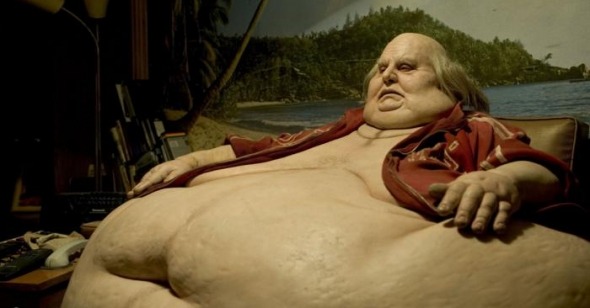The Way of All Flesh
by Eric Hynes
Taxidermia
Dir. Gyorgy Palfi, Hungary, Regent Releasing
A three-course ordeal of icky sex, Olympian gluttony, and autoerotic dismemberment, Gyorgy Palfi’s Taxidermia is consistently vile. Yet it’s also a sustained, unique work of art, and well worth the mess. A triptych, the first two sections of which are based on stories by Hungarian writer Lajos Parti Nagy (the third is an original story by Palfi and his wife, Zsofia Ruttkay, and they also cowrote the screenplay), the film chronicles three generations of men led and tormented by primal desires. A nervous, reclusive World War II soldier can’t control his burning sexual urges; his hulking son, a competitive speed eater in postwar Hungary, ravenously pursues success and respect; and a haunted grandson cares for his now massive, immobile father and plans for the ultimate in taxidermal preservation. Taxidermia operates as fable but communicates in viscera, a bracing contravention of flesh and fantasy.
Palfi’s aesthetic evokes the work of fabulists like Tim Burton, Terry Gilliam, and Jan Svankmajer, but he’s actually a more fluid filmmaker than those three; his approach is less dioramic and more breathlessly associative, more thoroughly surrealist. He rarely showcases his moments of genius, instead trolling deeper into unconscious impulses and visions. And though his decadent, dystopic, life-of-the-decaying-flesh worldview feels second hand and pat, his insatiable camera belies a hunger for life, a celebration of visual possibility. It’s this joy in creation that makes the film so compelling even as it transmits a steady, quite literal stream of bodily refuse and produce. Judging by sheer vomitous, bloody, ejaculative volume, Palfi’s second feature is easily the grossest film of the year. In terms of shot-making, it’s also one of the most impressive.
The film opens on Vendel Morosgovanyi, a hapless soldier at an iced-over outpost. His sexual frustrations are broadly comic: a rooster pecks him on the cock when he tries to copulate with a hole in the wall; he ogles the lieutenant’s plump wife; he humps a side of pork. But he finds satisfaction and power in fantasy, whether he’s transporting himself into a pop-up volume of Hans Christian Anderson’s “The Little Match Girl” (where he propositions her with sugarcoated smut), or making love to a lit candle, sensually sucking the flame into his deeply cleft harelip and igniting it on the tip of his penis. As realized by Csaba Czene (channeling Elias Koteas at his most disquietingly erotic), Vendel is cowed and proud, harmless and menacing, of-the-moment and doomed. Here sex and death are brutally inseparable, a theme Palfi touches on in the middle section before wrestling with it more overtly in the finale.
It’s fitting then that Vendel most resembles his ostensible grandson, Lajos (Mark Bischoff), the scrawny, self-immolating taxidermist. Yet Palfi confuses the paternal line. Is the middle man, competitive over-eater Kalman (Gergo Trocsanyi), really Vendel’s spawn? Is Lajos really his son? One man begets another in the narrative but there are multiple suitors at each conception—be they romantic rivals or frisky pigs—to subvert the idea that genealogy has any bearing on nature’s brutal inheritance.
Although each section could work as a freestanding piece, Palfi invites the viewer to recognize visual and textual rhyme, and he modulates tone within as well as between the sections. The first section is rife with sexual symbolism, but representation keeps veering into the inscrutable. The second starts as political satire, a high comic allegory of life under Soviet rule, then straightens into a character study and romance. Sight gags of fat people overeating gradually give way to shots of corpulent bodies as purposeful, even sensual, sites of marvel. Even revolting, prolonged sequences of competitors group vomiting into swimming-pool-sized receptacles take on a certain serene beauty: open mouths are gratified faucets, eyes are closed in an ecstasy of release. The Palfi-penned third section builds on Nagy’s bodily ruminations, grafting gothic horror onto contemporary miserablism before culminating in a morbidly realized work of “body art” that flagrantly—or is it ironically?—brings everything together.
Taxidermia‘s shape-shifting seems less like a sly dodge than an expression of philosophic ambiguity, and though that ambiguity—at least as willful as it is profound—merits greater scrutiny, Palfi’s film is still a sustained, remarkably articulated vision. For a final shot Palfi goes straight back, advancing inside a cavernous cadaver’s navel to the dark origins of the familiar and inscrutable.
